landslide
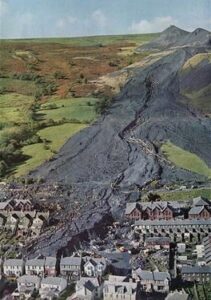 On the morning of October 21, 1966, a catastrophic collapse of a colliery spoil tip occurred on a mountain slope above the Welsh village of Aberfan, near Merthyr Tydfil. A spoil tip, also called a boney pile, culm bank, gob pile, waste tip, or…in Scotland, bing, is a pile built of accumulated spoil…waste material removed during mining. These waste materials are typically composed of shale, but they also contain smaller quantities of carboniferous sandstone and other residues. Spoil tips are not formed of slag, but in some areas, such as England and Wales, they are referred to as slag heaps. The area near Aberfan overlaid a natural spring, and a period of heavy rain led to a build-up of water within the tip which caused it to suddenly slide downhill as a slurry. The disaster killed 116 children and 28 adults, as it engulfed Pantglas Junior School and a row of houses. The accident left just five survivors and wiped out half the town’s youth. The Aberfan disaster became one of the United Kingdom’s worst coal mining accidents, but strangely it isn’t anything like a normal coal mining accident.
On the morning of October 21, 1966, a catastrophic collapse of a colliery spoil tip occurred on a mountain slope above the Welsh village of Aberfan, near Merthyr Tydfil. A spoil tip, also called a boney pile, culm bank, gob pile, waste tip, or…in Scotland, bing, is a pile built of accumulated spoil…waste material removed during mining. These waste materials are typically composed of shale, but they also contain smaller quantities of carboniferous sandstone and other residues. Spoil tips are not formed of slag, but in some areas, such as England and Wales, they are referred to as slag heaps. The area near Aberfan overlaid a natural spring, and a period of heavy rain led to a build-up of water within the tip which caused it to suddenly slide downhill as a slurry. The disaster killed 116 children and 28 adults, as it engulfed Pantglas Junior School and a row of houses. The accident left just five survivors and wiped out half the town’s youth. The Aberfan disaster became one of the United Kingdom’s worst coal mining accidents, but strangely it isn’t anything like a normal coal mining accident.
The colliery spoil tip was the responsibility of the National Coal Board (NCB), and the inquiry into the disaster placed the blame on the organization, also naming nine employees. When everything broke loose, the resulting landslide sent 140,000 cubic yards of coal waste in a tidal wave 40-feet high hurtling  down the mountainside where Merthyr Vale Colliery stood. The slide destroyed farmhouses, cottages, houses, and part of the neighboring County Secondary School. The avalanche is thought to have been the result of shoddy construction and a build-up of water in one of the colliery’s spoil tips…piles of waste material removed during mining.
down the mountainside where Merthyr Vale Colliery stood. The slide destroyed farmhouses, cottages, houses, and part of the neighboring County Secondary School. The avalanche is thought to have been the result of shoddy construction and a build-up of water in one of the colliery’s spoil tips…piles of waste material removed during mining.
Like many countries and areas, Wales was known for coal mining during the Industrial Revolution. Aberfan’s colliery opened in 1869. It didn’t take long for it to run out of space for waste, and by 1916 the space on the mountain valley floor was full. At that point, the colliery started “tipping” on the mountainside above the town. In 1966 it amassed seven tips containing 2.7 million cubic yards of colliery spoil.
Aberfan’s town council had contacted the National Coal Board to express concerns over the spoil tips years 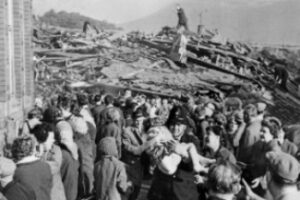 before the incident, following a non-lethal accident on the colliery. Unfortunately, they took no action at that time, and the issue was never addressed. The tip that fell on October 21 covered material that previously slipped. The disaster received widespread national attention. Queen Elizabeth II did not visit the site until eight days after the accident, and she admitted later that not going sooner was one of her biggest regrets. Once the disaster happened, little can be done to fix the matter, but the Mines and Quarries (Tips) Act was passed in 1969 to add provisions when using mining tips, among other things. Sadly it was too late for those lost, but it was good news for future miners and the surrounding towns.
before the incident, following a non-lethal accident on the colliery. Unfortunately, they took no action at that time, and the issue was never addressed. The tip that fell on October 21 covered material that previously slipped. The disaster received widespread national attention. Queen Elizabeth II did not visit the site until eight days after the accident, and she admitted later that not going sooner was one of her biggest regrets. Once the disaster happened, little can be done to fix the matter, but the Mines and Quarries (Tips) Act was passed in 1969 to add provisions when using mining tips, among other things. Sadly it was too late for those lost, but it was good news for future miners and the surrounding towns.
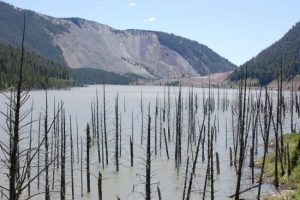 I read in the paper on Monday about the 57th anniversary of the August 17, 1959 Hebgen Earthquake that created Earthquake Lake in Montana, just west of Yellowstone National Park. The 7.5 magnitude earthquake was the second strongest quake in the lower 48 states in the 20th century, according to the United States Forest Service, killing 28 people, including five people in one Idaho Falls family who were entombed in the ensuing landslide, and are still there to this day. I was only three years old when that quake occurred, so I wouldn’t remember it, nor am I aware that it was felt in Casper, Wyoming, where we live, although it might have been felt there too. Still, I doubt I would have remembered it.
I read in the paper on Monday about the 57th anniversary of the August 17, 1959 Hebgen Earthquake that created Earthquake Lake in Montana, just west of Yellowstone National Park. The 7.5 magnitude earthquake was the second strongest quake in the lower 48 states in the 20th century, according to the United States Forest Service, killing 28 people, including five people in one Idaho Falls family who were entombed in the ensuing landslide, and are still there to this day. I was only three years old when that quake occurred, so I wouldn’t remember it, nor am I aware that it was felt in Casper, Wyoming, where we live, although it might have been felt there too. Still, I doubt I would have remembered it.
What I do remember, is the trip our family took when I was a child, that included Earthquake Lake. I don’t recall whether I was told about the 28 people who died there, or the ones they never found, but I rather doubt  it, because things like that tend to be something that sticks with me…even really bothering me when I was younger, because I almost felt like I was a trespasser on their graves. These days, I realize that being near someone’s grave, whether in a cemetery or a natural grave such as Earthquake Lake became, is still nothing more than a final resting place. What impresses me more now is the sadness of the loss. That family was on vacation, and suddenly their lives were gone…over in an instant. Along with the loss of life, there was the damage to roads, making it even harder to bring help in to the people who were trapped, although I’m not sure it would have made much difference.
it, because things like that tend to be something that sticks with me…even really bothering me when I was younger, because I almost felt like I was a trespasser on their graves. These days, I realize that being near someone’s grave, whether in a cemetery or a natural grave such as Earthquake Lake became, is still nothing more than a final resting place. What impresses me more now is the sadness of the loss. That family was on vacation, and suddenly their lives were gone…over in an instant. Along with the loss of life, there was the damage to roads, making it even harder to bring help in to the people who were trapped, although I’m not sure it would have made much difference.
I remember feeling the enormity of the catastrophic event that took place that day a number of years earlier. I was impressed by the ability of an earthquake to change the face of the landscape around it. What had been the Madison River, was blocked by a massive landslide creating Earthquake Lake. The deaths were random. A couple, Edgar and Ethel Stryker were killed by a boulder that crushed them, while their three young sons, 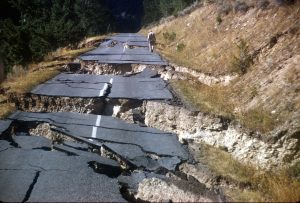 sleeping in a nearby tent, were unhurt. Irene Bennett and her son Phil were saved, but her husband Purley and their three other children were killed. Myrtle Painter died of her injuries, while her 16 year old daughter Carole survived. That was the story of the event, this one died, and that one lived. I think that while I probably didn’t know about all those deaths, that I still felt the sadness of that place, because it is a place I have never forgotten. An earthquake that happens in a rural area seems to make us think that it was simple a change of the landscape, but that is rarely the case. It seems that there are almost always a few people in the area, and that means a loss of life. A very sad event indeed.
sleeping in a nearby tent, were unhurt. Irene Bennett and her son Phil were saved, but her husband Purley and their three other children were killed. Myrtle Painter died of her injuries, while her 16 year old daughter Carole survived. That was the story of the event, this one died, and that one lived. I think that while I probably didn’t know about all those deaths, that I still felt the sadness of that place, because it is a place I have never forgotten. An earthquake that happens in a rural area seems to make us think that it was simple a change of the landscape, but that is rarely the case. It seems that there are almost always a few people in the area, and that means a loss of life. A very sad event indeed.
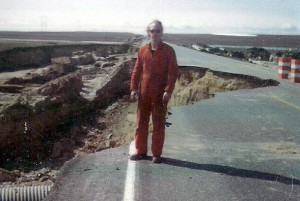 I am often amazed at the changes in our weather. No, I don’t buy into the Global Warming thing, which is ridiculous, but I do think our weather runs in cycles. We have droughts and then wet years. We have years with little snow and years with huge spring runoffs. Back in the 1980’s, while Bob was working at Shirley Basin in the Uranium mines, we has one of those huge runoff years. It had snowed an awful lot that year, especially in the mountains, and when Spring arrived, there was so much water that it caused part of the road he drove to and from work to wash out. I know this kind of thing happens periodically, but this was really our first experience with anything like this.
I am often amazed at the changes in our weather. No, I don’t buy into the Global Warming thing, which is ridiculous, but I do think our weather runs in cycles. We have droughts and then wet years. We have years with little snow and years with huge spring runoffs. Back in the 1980’s, while Bob was working at Shirley Basin in the Uranium mines, we has one of those huge runoff years. It had snowed an awful lot that year, especially in the mountains, and when Spring arrived, there was so much water that it caused part of the road he drove to and from work to wash out. I know this kind of thing happens periodically, but this was really our first experience with anything like this.
It was quite a big deal. They had to make a way for the men to get around there so they could get to work and I believe that for a time, that meant taking the long way around, adding time to the drive home. Thankfully this was a big enough issue that the highway department got things fixed in a big hurry, but for a time it was quite the novelty. I think probably every person that worked at the mines had their picture taken at the site of the washout. It was the only washout that occurred in the years that Bob worked at Shirley Basin, even though we have had other bad flood years since that time.

One such washout, or in this case, landslide, happened in May 2011, when a huge hillside near Jackson, Wyoming blocked Highway 26/89 for 10 days. And then there was the flood that practically wiped out Kaycee, Wyoming in August 2002, wiping out one of the bridges on I-25. Even though these situations were not the first ones I had ever heard of, they still shocked me in a big way. Wyoming is normally such a dry state, that to think of floods and landslides is unusual. It’s just something that can happen in any state if the conditions are right.

